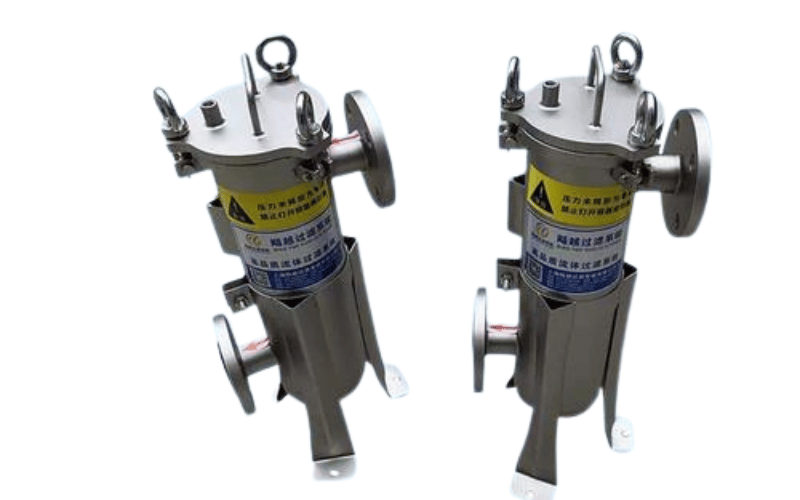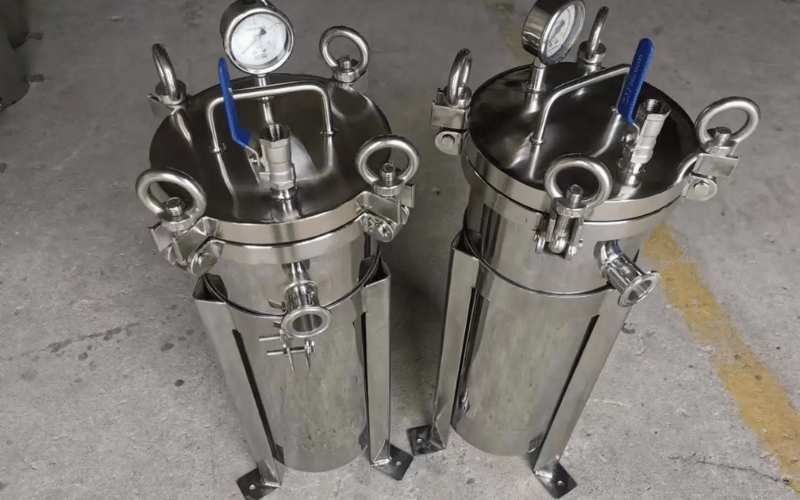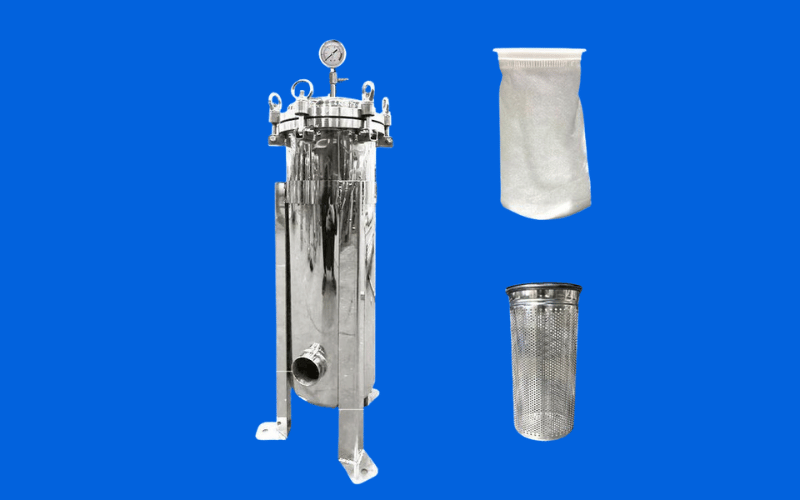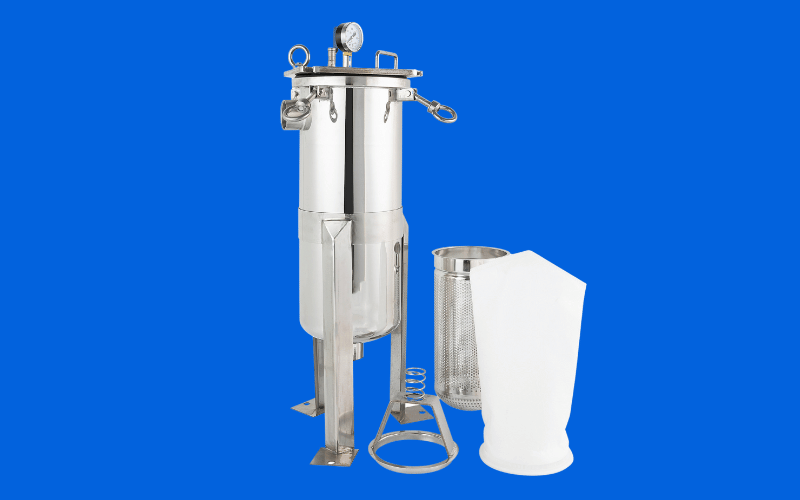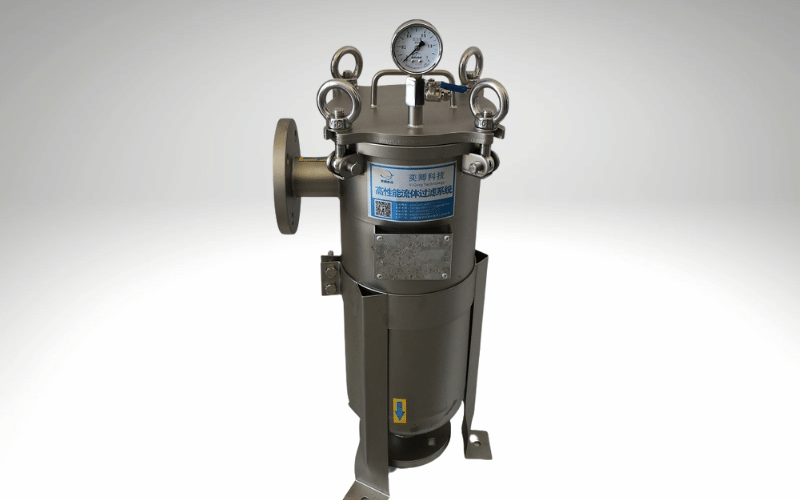Flat Cover Single Bag Filter
Home » Filter Housing » Single Bag Filter Housing » Flat Cover Single Bag Filter
Efficient Filtration | Long Service Life | Customizable Options
The Flat Cover Single Bag Filter is designed to streamline and elevate your filtration process. With its side-in, bottom-out filtration system and flexible side-in pipe connection options, this filter adapts to your unique setup while delivering reliable performance. Its robust construction and innovative design make it an economical yet highly effective choice for handling filtration tasks under high-pressure conditions.
Technical Specifications
| Parameter | Value | Description |
|---|---|---|
| Maximum Flow Rate | 40 m³/h | Maximum volume of fluid filtered per hour. |
| Maximum Operating Temperature | 150°C | Highest temperature the filter can safely handle during operation. |
| Maximum Operating Pressure | 10 bar (145 psi) | For 01/02 bag size, the maximum pressure the filter can withstand. |
| 16 bar (232 psi) | For 03/04 bag size, the maximum pressure the filter can withstand. |
Why Choose the Flat Cover Single Bag Filter?
- Highly Effective and Mess-Free Operation
A side-entry inlet and removable top cover work together to prevent liquid overflow when the filter is opened, keeping your workspace clean and hassle-free. - Leak-Free Performance You Can Trust
The top cover features a unique sealing design integrated with a secure handle. This ensures a tight seal, eliminating bypass leakage for consistently reliable filtration. - Built to Withstand High Pressure
Crafted as a single piece, the bolted top cover guarantees complete sealing even in high-pressure scenarios, offering peace of mind during demanding operations. - Simplified Maintenance
A high-quality, electro-polished support basket provides sturdy, full support for the filter bag and is designed for effortless cleaning, minimizing downtime. - Easy and Flexible Installation
Adjustable, stable support legs make installation simple, no matter the setup, ensuring excellent adaptability for a variety of applications.
The Flat Cover Single Bag Filter combines durability, user-friendly design, and efficiency to meet your filtration needs. Whether you’re looking for a system that minimizes maintenance or guarantees performance under pressure, this filter has you covered.
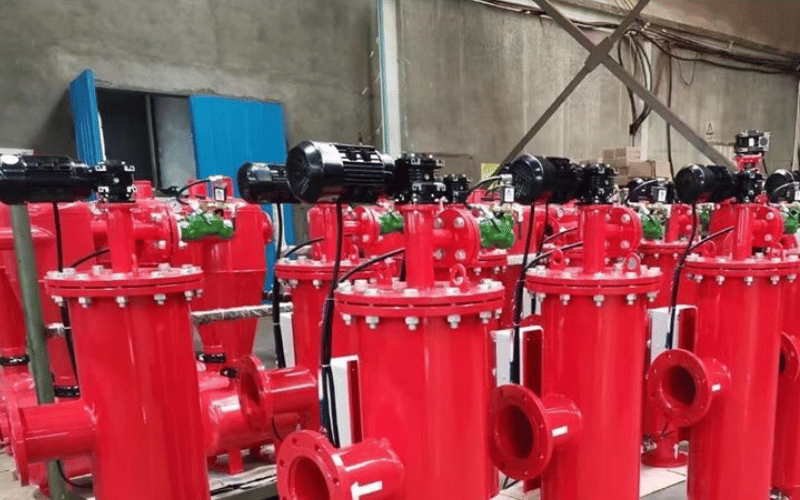
What is the Filtration Process Involved in a Flat Cover Single Bag Filter?
At its core, the Flat Cover Single Bag Filter is engineered to deliver a seamless and efficient filtration experience. Designed to handle diverse applications, its filtration process is rooted in precision, reliability, and convenience. Utilizing a side-in, bottom-out method, our filter ensures that unfiltered liquids pass through with minimal resistance, while impurities are effectively trapped in the filter bag. This process maintains the quality of the output liquid while optimizing the service life of the filter components.
To ensure adaptability, the system offers customizable inlet pipe directions, allowing seamless integration into your existing setups. The robust yet simple structure reflects our commitment to providing filtration solutions that are easy to maintain, minimize downtime, and meet the demands of high-performance industries.
Step-by-Step Overview of the Filtration Process
We’ve streamlined our Flat Cover Single Bag Filter to make the filtration process straightforward and effective. Here’s a step-by-step breakdown:
1. Liquid Entry (Side-In):
Unfiltered liquid enters through the side-entry inlet. This design minimizes turbulence, ensuring a steady flow of fluid into the filter.
2. Directional Flow (Bottom-Out):
The liquid flows downward through the filter basket, which provides firm support for the filter bag and maximizes filtration efficiency. This design guarantees uniform exposure to the filter medium.
3. Filtrate Collection:
Clean, filtered liquid exits through the dedicated bottom-out discharge pipe. This side-in, bottom-out configuration facilitates smooth liquid flow and prevents back-pressure buildup.
4. Impurity Retention:
During the process, suspended particles and contaminants are captured in the high-quality filter bag. The bag’s durable construction allows it to handle fine and coarse impurities with ease.
5. Maintenance and Cleaning:
When cleaning or replacing the filter bag, the top cover can be easily removed, thanks to its handle-integrated design. Our bolted one-piece top cover ensures that no residual liquid overflows during maintenance, enhancing operational safety and hygiene.
Designed with user convenience in mind, every step of the filtration process prioritizes efficiency, reliability, and ease of handling.
Importance of Proper Seal and Pressure Maintenance
A well-sealed system is critical to filtration efficiency, and we have addressed this with a unique sealing solution. Our filter’s bolted, one-piece flat cover ensures complete sealing, even under high-pressure conditions. Whether your filter is operating at a maximum pressure of 10 bar (145 psi) for 01/02 bag sizes or 16 bar (232 psi) for 03/04 bag sizes, you can rely on its secure fixation to eliminate the risk of bypass leakage.
Proper sealing is essential not only for maintaining filtration integrity but also for safeguarding the surrounding environment. With secure seals in place, there is no contamination or liquid leakage, ensuring the safety of both the workspace and the operators. Pressure maintenance also plays a significant role, as fluctuations can lead to damage to the filter media and compromise the filtration results. Our design withstands pressure variations, ensuring consistent performance even under demanding conditions.
Common Issues and Troubleshooting Tips
To ensure your Flat Cover Single Bag Filter delivers optimal results, it’s essential to recognize and address common issues that may arise during operation. Allow us to share some troubleshooting tips based on common filtration challenges:
1. Uneven Filtration or Bypass Leakage:
- Cause: Improper sealing or bag misalignment.
- Solution: Regularly inspect the top cover’s bolted seal and ensure precise alignment of the filter bag with the support basket.
2. Reduced Filtration Efficiency:
- Cause: Clogged or worn-out filter bag.
- Solution: Replace the filter bag based on usage and pollutant load. Frequent cleaning of the support basket also helps maintain efficiency.
3. Pressure Drop in the System:
- Cause: Excessive buildup of impurities in the bag.
- Solution: Monitor pressure indicators and schedule timely maintenance when the pressure differential reaches the critical limit.
4. Leaks at the Connections:
- Cause: Faulty pipe connections or damaged O-rings.
- Solution: Check all pipe connectors and replace any defective O-rings to maintain a tight seal.
5. Overflow During Maintenance:
- Cause: Improper liquid handling or hasty maintenance procedures.
- Solution: Use the removable, handle-integrated top cover to safely access the filter bag without spilling. Always depressurize the system before maintenance.
At the heart of addressing these issues lies regular monitoring and adherence to recommended maintenance schedules. With our Flat Cover Single Bag Filter, many potential problems can be mitigated through its user-friendly design and durable components.
Final Thoughts
Our Flat Cover Single Bag Filter is a blend of precision engineering and practical design, making it ideal for a wide range of industrial applications. Whether you are in automotive coatings, fine chemicals, food processing, or the electronics sector, this filter not only meets but exceeds expectations. By understanding its filtration process, prioritizing proper sealing and pressure maintenance, and addressing common challenges with confidence, you can ensure reliable and consistent results.
We’ve taken the guesswork out of filtration so you can focus on delivering quality in your operations. Should you need further guidance or replacement accessories, we are here to assist every step of the way. Experience the power of streamlined filtration with our Flat Cover Single Bag Filter!
Maintenance Guide for the Flat Cover Single Bag Filter
How Often Should You Replace the Filter Bag?
The lifespan of a filter bag primarily depends on the nature of your application, the type of liquid being filtered, and the load of impurities. While filter bags typically last for multiple filtration cycles, we recommend inspecting and replacing them based on usage patterns and operational demands.
For most industrial applications, it’s ideal to replace the filter bag before it reaches its capacity to ensure optimal filtration performance. Regular monitoring of pressure differentials can help determine when the bag has reached its limit. For instance:
- High-load applications (e.g., automotive coatings or fine chemicals): Replacement may be needed frequently, anywhere between one and two weeks.
- Low-load applications (e.g., water filtration or light-duty tasks): Filter bags may last up to a month or longer.
Keeping track of your specific operating conditions enables more precise scheduling of replacements, resulting in minimal downtime and superior results.
Signs That Indicate It’s Time to Replace the Filter Bag
If you’re unsure when to replace the filter bag, watch for the following signs that indicate reduced efficiency or wear:
- Clogged or Saturated Filter Bag: A noticeable drop in flow rate or increasing pressure differential may signal that the filter bag is clogged.
- Visible Wear or Damage: Tears, holes, or thinning in the bag material compromise its effectiveness and require immediate replacement.
- Poor Filtration Quality: The presence of unfiltered particles in the output liquid indicates that the bag is underperforming or no longer retaining contaminants properly.
- Changes in Operating Pressure: Excessive pressure buildup in the system is another clear indicator that the filter bag needs replacement.
- Discoloration or Fouling: Heavy discoloration of the bag or the buildup of difficult-to-clean deposits indicates that the bag has reached the end of its usability.
Regularly checking for these signs ensures reliable filtration and prevents unexpected interruptions.
Guidelines for Regular Maintenance
Proper maintenance prolongs the life of your Flat Cover Single Bag Filter and keeps the system operating efficiently. Here are our recommended guidelines:
- Inspect the System Weekly: Check the filter bag, support basket, and sealing mechanisms for any visible wear or damage.
- Monitor Pressure Differentials: Install a pressure gauge to monitor the pressure differential between the inlet and outlet—schedule maintenance when the pressure exceeds the recommended range.
- Clean the Support Basket: After replacing the very filter bag, remove and clean the support basket to eliminate residual contaminants.
- Depressurize Before Maintenance: Always relieve system pressure before opening the top cover to avoid spills or safety hazards.
- Keep Spare Filter Bags Readily Available: Stock up on replacement bags matching your application’s specifications to ensure smooth operations.
By following these steps, you’ll maintain consistent filtration quality, reduce operational downtime, and extend the overall lifespan of your filter components.
Cost Considerations for Filter Bag Media
We understand that cost is a crucial factor in managing filtration systems. Filter bag media prices can vary depending on the material, size, and application requirements. To help optimize costs without compromising quality, consider the following factors:
- Material Selection: Our filter bags are available in various materials, including polypropylene, polyester, and nylon. Select the one that best suits your application in terms of durability and efficiency.
- Reusability: Some filter bags are washable and reusable, providing a cost-effective solution for low-load applications.
- Batch Discounts: Purchasing filter bags in bulk often results in savings and ensures long-term availability for your system.
- Operational Cost Balance: Replacing filter bags proactively may incur a small cost, but it prevents issues such as system clogging, which can lead to higher expenses for repairs or downtime.
By investing in quality filter bags and adopting a proactive replacement schedule, you can effectively manage costs while maintaining superior performance.
Final Thoughts
Maintaining your Flat Cover Single Bag Filter is essential for ensuring peak functionality and longevity. By regularly inspecting the filter bags, recognizing signs of wear, and adhering to maintenance schedules, you can achieve consistent filtration results and minimize interruptions. Should you need guidance in selecting filter bag media or calculating replacement schedules, we are here to provide expert support. Count on us for quality, reliability, and peace of mind when it comes to your filtration needs!
FAQs About Flat Cover Single Bag Filter
Q: What is a Flat Cover Single Bag Filter and how does it function within a filter vessel?
A: A Flat Cover Single Bag Filter is a type of filtration system designed to remove particulates from liquids. It functions within a filter vessel where the liquid enters through an inlet, passes through the bag housing and mesh, and exits the vessel as a filtered liquid. The bag filter effectively captures solids, ensuring high-quality water filtration.
Q: What materials are typically used in the construction of a bag housing for a Flat Cover Single Bag Filter?
A: The bag housing for a Flat Cover Single Bag Filter is commonly constructed from materials such as stainless steel (304 or 316) or carbon steel. These materials provide durability and resistance to high temperatures and pressures, ensuring the longevity and sealing performance of the filter system.
Q: How do I determine the appropriate inlet flange size for a Flat Cover Single Bag Filter?
A: The appropriate inlet flange size for a Flat Cover Single Bag Filter can be determined based on the flow rate and the specifications of the filter vessel. It is important to match the inlet flange size with the system requirements to ensure effective filtration and prevent leakage.
Q: Can you explain the purpose of the support basket inside the bag housing?
A: The support basket inside the bag housing serves to hold the filter bag in place while allowing the filtered liquid to pass through. It provides structural support and prevents the bag from collapsing under pressure, ensuring optimal filtration performance.
Q: What role do basket strainers play in conjunction with Flat Cover Single Bag Filters?
A: Basket strainers are used in conjunction with Flat Cover Single Bag Filters to provide an additional layer of filtration. They can trap larger particles before they reach the bag filter, thereby extending the life of the bag and improving overall filtration efficiency.
Q: How is the sealing performance of a Flat Cover Single Bag Filter ensured?
A: The sealing performance of a Flat Cover Single Bag Filter is ensured through the use of high-quality gaskets and bolting mechanisms, such as swing bolts or eye bolts, which lock the cover securely onto the bag housing. This prevents any leakage and maintains the integrity of the filtration process.
Q: What types of applications are Flat Cover Single Bag Filters typically used for?
A: Flat Cover Single Bag Filters are typically used in various industrial applications, including water filtration, chemical processing, and food and beverage production. They are effective in filtering solids from liquids in these settings, ensuring the quality of the final product.
Q: How can I maintain my Flat Cover Single Bag Filter for optimal performance?
A: To maintain optimal performance of your Flat Cover Single Bag Filter, regular inspections and cleaning should be performed. This includes checking for signs of wear on the bag and housing materials, ensuring that the sealing components are intact, and replacing the filter bag as needed to avoid clogging and maintain effective filtration.
Q: What should I consider when selecting a bag filter for high flow applications?
A: When selecting a bag filter for high flow applications, it is important to consider factors such as the flow rate, the size of the inlet and outlet, the mesh size of the filter bag, and the housing materials. Ensuring that the filter vessel can accommodate high flow rates without compromising filtration efficiency is crucial.


